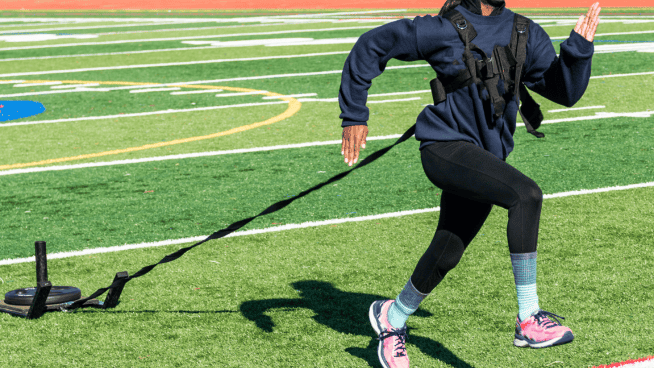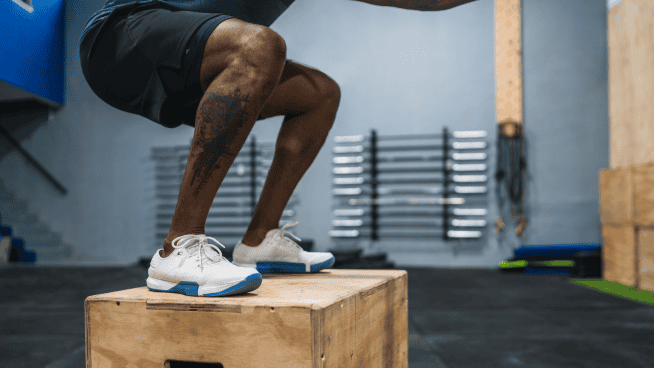5 Soccer Strength Exercises You Can Perform Anywhere
Here’s a sad truth: Soccer players don’t strength train enough.
With the hectic life of the modern student-athlete, including games, practices, school, homework and more, something’s got to give. For soccer players, this something is often a consistent presence in the weight room.
I get it—it’s tough. But if young players don’t increase their strength over time, they put a hard cap on their own potential. So how can we make strength training more accessible and convenient for our young soccer players? How can we make it something that gives them a better shot of realistically including it in their routines?
The solution is on-field strength training. I’m a performance coach and firmly believe in the magic of the weight room for helping athletes reach their peak performance, but I also believe a gym is not required to help players get stronger. This is especially true for younger players who have loads of room to grow when it comes to building strength and muscle mass.
While elite players may need the type of progressive overload only heavy weights can offer, on-field strength training via the use of bodyweight exercises will be enough for many players to get stronger. Although it’s not ideal in terms of exercise physiology adaptations, it’s far better than doing nothing.
Instead of players making excuses for why they can’t get into the weight room, let’s meet them halfway and incorporate strength movements into our on-field training sessions. With that in mind, here are five simple soccer strength exercises that can be performed anywhere.
1. Ball Hamstring Walk-Out
More often than not, soccer players have weak posterior chains. This limits their ability, as posterior muscle groups like the glutes and hamstrings play a pivotal role in important actions like sprinting, acceleration, changing directions and stabilizing the knee.
The Ball Hamstring Walk-Out is stellar for honing eccentric hamstring control as it allows for a great amount of time under tension. Better eccentric hamstring control translates to improved performance and a reduced risk of injury.
How to Program It: Perform 2-3 sets of 4-6 repetitions (1 rep = walk out and back). I recommend having players perform this either prior to a light practice session or at the end of a hard practice session as a sort of cool down. Eccentric training places a lot of stress on the muscles, so it’s best to limit this to once or twice a week. Try to avoid performing these directly prior to a competition.
2. Side Plank with Hip Adduction
Chances are that you have access to a bench at practice. If not, this exercise can easily be performed with a teammate or partner holding up the non-moving leg.
I like this exercise because it incorporates a number of important attributes for soccer players into one movement, including hip stability, core stability (anti-rotation and anti-extension), hip adduction and shoulder stability. The hip adduction component is the main benefit of this exercise in my opinion, as it strengthens the groin area and the adductor longus, in particular. This muscle is often prone to strains in soccer players.
How to Program It: Perform 2-3 sets of 8-10 repetitions on each side. Open up the chest, reach the hand to the sky and ensure the body is in one continuous line. Control the moving leg and do not rush. This exercise is OK to do twice a week before practice as an activation movement.
3. Quadruped Plank
Core stability is one of the most underrated performance aspects of soccer. It allows players to better control their center of mass when changing directions, transfers power more efficiently when shooting, improves posture for running at maximal speeds and keeps the lower extremities stable during play, reducing risk of injury. The Quadruped Plank reinforces anterior core and lumbar spine stability, as well as hip and shoulder stability.
How to Program It: Perform 2-3 sets of 30-60 seconds while changing the direction of the ball around the cone halfway through the duration. This exercise can be a great core activator prior to any practice. I would recommend this exercise be performed two to three times a week. Keep the hips still by keeping the belly button facing the ground at a fixed point. The hand should be placed underneath the shoulder, with the other hand working the ball around the cone. Keep the knees off the ground, but low enough so that the butt does not come higher than the head.
4. Inchworm Complex
Push-Ups can be performed anywhere, but they’re often performed with poor form and largely ignore the lower-body muscle groups which are so critical for soccer players.
The Inchworm Complex is a better choice. This exercise can also be performed anywhere, but it incorporates more important performance pieces such as ankle dorsiflexion (improve running mechanics), hip mobility (important in changing direction), and core stability (controlling balance and center of mass when shooting and changing direction).
How to Program It: This can be done within the dynamic warm-up since there is a major flexibility component (calves, hamstrings) as well as ankle mobility (dorsiflexion). Perform for 45-60 consecutive seconds, two to three times a week.
5. Manual Lateral Lunge
For players to improve their agility, they must know how to move within the frontal plane. I’d argue that not enough lateral work is included in most athletes’ strength training routines. This lateral lunge variation is a great partner exercise for improving frontal strength and learning how to decelerate more efficiently.
How to Program It: This is a good warm-up exercise because it also helps to groove hip mobility. Perform 2-3 sets and 5 reps on each side. Perform the move twice a week. Make sure the chest is projected forward and the torso does not collapse forward. Keep the non-working leg straight, and sink your butt back in your working leg.
Even though you’re not getting in the weight room, performing these on-field bodyweight exercises will compound over time and help players gain a good foundation of strength. Ideally, every soccer player would have the time and drive to get in the weight room on a consistent basis. But something is always better than nothing when it comes to improving performance and reducing the risk of injury.
RECOMMENDED FOR YOU
MOST POPULAR
5 Soccer Strength Exercises You Can Perform Anywhere
Here’s a sad truth: Soccer players don’t strength train enough.
With the hectic life of the modern student-athlete, including games, practices, school, homework and more, something’s got to give. For soccer players, this something is often a consistent presence in the weight room.
I get it—it’s tough. But if young players don’t increase their strength over time, they put a hard cap on their own potential. So how can we make strength training more accessible and convenient for our young soccer players? How can we make it something that gives them a better shot of realistically including it in their routines?
The solution is on-field strength training. I’m a performance coach and firmly believe in the magic of the weight room for helping athletes reach their peak performance, but I also believe a gym is not required to help players get stronger. This is especially true for younger players who have loads of room to grow when it comes to building strength and muscle mass.
While elite players may need the type of progressive overload only heavy weights can offer, on-field strength training via the use of bodyweight exercises will be enough for many players to get stronger. Although it’s not ideal in terms of exercise physiology adaptations, it’s far better than doing nothing.
Instead of players making excuses for why they can’t get into the weight room, let’s meet them halfway and incorporate strength movements into our on-field training sessions. With that in mind, here are five simple soccer strength exercises that can be performed anywhere.
1. Ball Hamstring Walk-Out
More often than not, soccer players have weak posterior chains. This limits their ability, as posterior muscle groups like the glutes and hamstrings play a pivotal role in important actions like sprinting, acceleration, changing directions and stabilizing the knee.
The Ball Hamstring Walk-Out is stellar for honing eccentric hamstring control as it allows for a great amount of time under tension. Better eccentric hamstring control translates to improved performance and a reduced risk of injury.
How to Program It: Perform 2-3 sets of 4-6 repetitions (1 rep = walk out and back). I recommend having players perform this either prior to a light practice session or at the end of a hard practice session as a sort of cool down. Eccentric training places a lot of stress on the muscles, so it’s best to limit this to once or twice a week. Try to avoid performing these directly prior to a competition.
2. Side Plank with Hip Adduction
Chances are that you have access to a bench at practice. If not, this exercise can easily be performed with a teammate or partner holding up the non-moving leg.
I like this exercise because it incorporates a number of important attributes for soccer players into one movement, including hip stability, core stability (anti-rotation and anti-extension), hip adduction and shoulder stability. The hip adduction component is the main benefit of this exercise in my opinion, as it strengthens the groin area and the adductor longus, in particular. This muscle is often prone to strains in soccer players.
How to Program It: Perform 2-3 sets of 8-10 repetitions on each side. Open up the chest, reach the hand to the sky and ensure the body is in one continuous line. Control the moving leg and do not rush. This exercise is OK to do twice a week before practice as an activation movement.
3. Quadruped Plank
Core stability is one of the most underrated performance aspects of soccer. It allows players to better control their center of mass when changing directions, transfers power more efficiently when shooting, improves posture for running at maximal speeds and keeps the lower extremities stable during play, reducing risk of injury. The Quadruped Plank reinforces anterior core and lumbar spine stability, as well as hip and shoulder stability.
How to Program It: Perform 2-3 sets of 30-60 seconds while changing the direction of the ball around the cone halfway through the duration. This exercise can be a great core activator prior to any practice. I would recommend this exercise be performed two to three times a week. Keep the hips still by keeping the belly button facing the ground at a fixed point. The hand should be placed underneath the shoulder, with the other hand working the ball around the cone. Keep the knees off the ground, but low enough so that the butt does not come higher than the head.
4. Inchworm Complex
Push-Ups can be performed anywhere, but they’re often performed with poor form and largely ignore the lower-body muscle groups which are so critical for soccer players.
The Inchworm Complex is a better choice. This exercise can also be performed anywhere, but it incorporates more important performance pieces such as ankle dorsiflexion (improve running mechanics), hip mobility (important in changing direction), and core stability (controlling balance and center of mass when shooting and changing direction).
How to Program It: This can be done within the dynamic warm-up since there is a major flexibility component (calves, hamstrings) as well as ankle mobility (dorsiflexion). Perform for 45-60 consecutive seconds, two to three times a week.
5. Manual Lateral Lunge
For players to improve their agility, they must know how to move within the frontal plane. I’d argue that not enough lateral work is included in most athletes’ strength training routines. This lateral lunge variation is a great partner exercise for improving frontal strength and learning how to decelerate more efficiently.
How to Program It: This is a good warm-up exercise because it also helps to groove hip mobility. Perform 2-3 sets and 5 reps on each side. Perform the move twice a week. Make sure the chest is projected forward and the torso does not collapse forward. Keep the non-working leg straight, and sink your butt back in your working leg.
Even though you’re not getting in the weight room, performing these on-field bodyweight exercises will compound over time and help players gain a good foundation of strength. Ideally, every soccer player would have the time and drive to get in the weight room on a consistent basis. But something is always better than nothing when it comes to improving performance and reducing the risk of injury.










